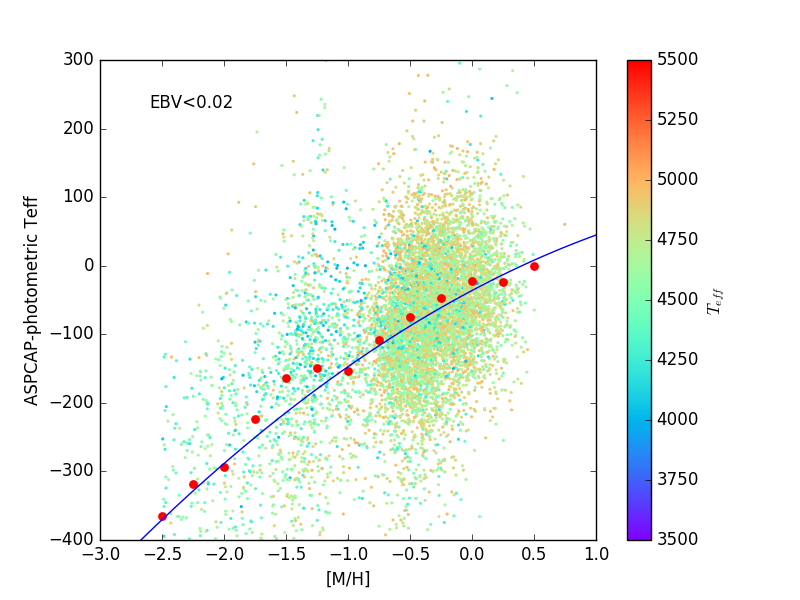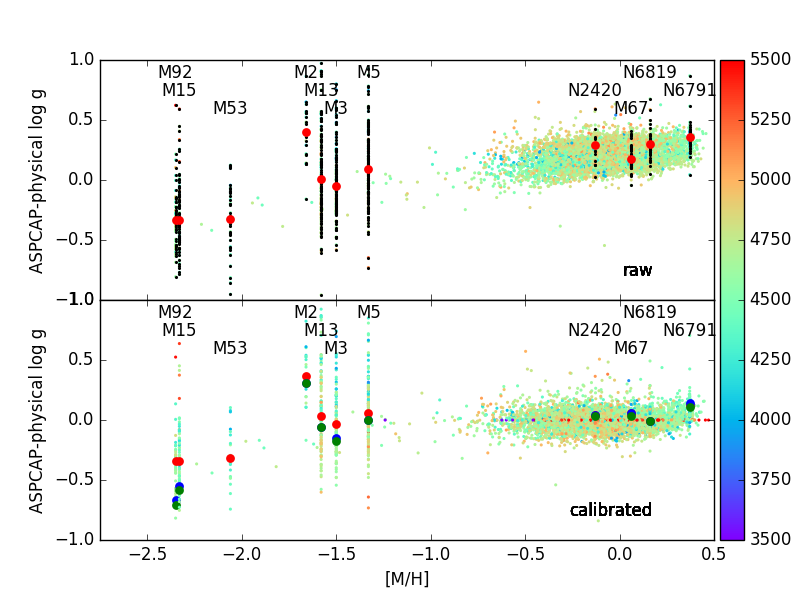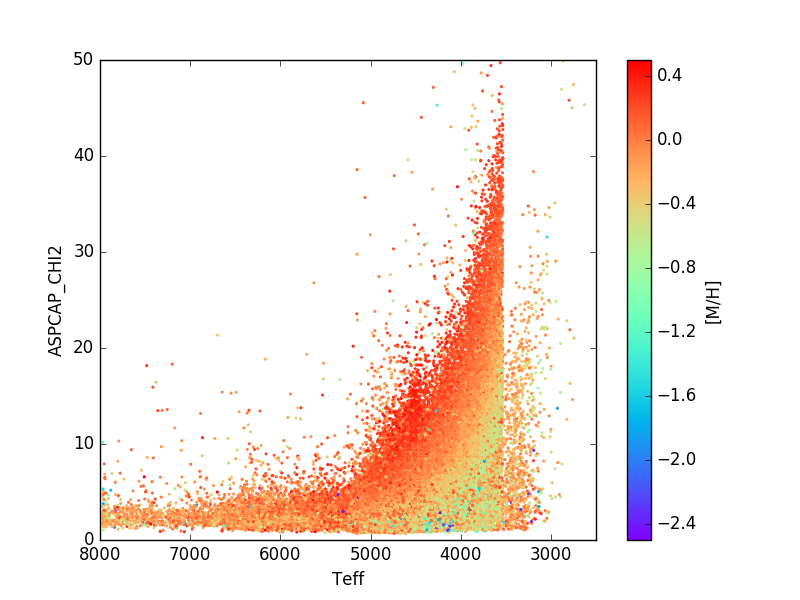Using APOGEE Stellar Parameters
The APOGEE Stellar Parameters and Abundances Pipeline (ASPCAP) works in two steps: it first determines stellar parameters using a global fit over the entire spectral range, and then it fits sequentially for individual elemental abundances over limited spectral windows using the initially derived parameters. For more information, see the pages on the ASPCAP pipeline. Note that the fundamental parameters affecting the IR spectra can include both traditional parameters (effective temperature, surface gravity, and overall metallicity) but also some initial estimates of abundances.
APOGEE uncertainties
APOGEE reports uncertainties as standard deviations.
This is in contrast to the optical spectral pipelines (such as the Optical Spectroscopy Pipeline or the SEGUE Stellar Parameter Pipeline), which typically report uncertainties as inverse variances.
The basic stellar parameters — effective temperature and surface gravity — are scientifically important (e.g., in the determination of distances), but the global-fit abundance parameters may also be of utility, as they provide an average abundance of multiple elements as determined from the entire spectrum.
If you are interested in using effective temperatures and/or surface gravities, read the sections on these quantities below, since we recommend some modifications of the values released with DR13!
The individual element abundances depend on the stellar parameters, so the accuracy of the latter is important for abundance determination. However, we note that the best-fitting effective temperature and surface gravity may not best the best physical estimates of those quantities, since the nature of the spectral analysis includes some approximations that may not be satisfied, e.g., the use of LTE, 1D plane parallel atmospheres. APOGEE/ASPCAP takes the approach of using the best-fitting parameters to derive abundances.
ASPCAP Parameter Tags/Columns
As described in the ASPCAP page, calibration relations have been applied to some of the ASPCAP parameters. We provide uncalibrated parameters for all stars, and calibrated parameters for a subset. In the summary data files (see parameter summary FITS files for information on how to access), the uncalibrated parameters are stored in an array called FPARAM, while calibrated parameters are stored in a PARAM array. For convenience, the summary data files also include explicit columns that restate the calibrated parameters of the PARAM array: TEFF, LOGG, M_H, ALPHA_M (note the name change for the latter two quantities; in DR12, we used PARAM_M_H and PARAM_ALPHA_M).
In the Catalog Archive Server (CAS) (see parameter tables for queries for access information), each parameter value is given its own column name: TEFF, LOGG, M_H, and ALPHA_M for the calibrated parameters, and FPARAM_TEFF, FPARAM_LOGG, FPARAM_M_H, FPARAM_C_M, FPARAM_N_M, and FPARAM_ALPHA_M for the uncalibrated parameters.
Regardless of how you get the parameters, it is important to pay attention to how the data have been flagged, because not all of the values are reliable. This is particularly true for uncalibrated values. For information on the flags, see the bitmask section below.
Quality of the ASPCAP Stellar Parameters
Effective temperature (Teff)
The accuracy of the ASPCAP-determined effective temperatures has been gauged by comparisons to photometrically-derived temperatures for a sample of low-reddened giants. For the bulk of the APOGEE sample, which is near solar metallicity, the ASPCAP temperatures roughly approximate those determined from the colors. Due to this as well as the potential uncertainties in the photometric metallicity scale, we made the choice not to apply any calibration to the derived effective temperatures; this differs from DR12, where we applied an offset of about 90 K. Accordingly, for DR13, the raw and calibrated effective temperatures are identical.
Subsequent to the freezing of DR13, however, we uncovered a significant trend in the difference between the spectroscopic temperature and photometric temperatures with metallicity, as shown in the Figure.
Consequently, for the best estimate of physical effective temperatures, we recommend the application of an approximate post-calibration to the ASPCAP effective temperatures:
As a result, the effective temperatures for metal-poor stars should be revised upwards to warmer values.
We have used the scatter in the comparison with effective temperatures (without metallicity term) to provide an empirical estimate of the random errors. And so, we adopted scatter/√2 for the temperature uncertainty (since the photometric temperatures have their own uncertainties).
Surface gravity (log g)
Surface gravities have been checked/calibrated using observations of asteroseismic stars from the Kepler field, for which independent surface gravities can be obtained. These comparisons suggest that the ASPCAP gravities are still systematically high, although by less than they were for DR12. There continues to be a puzzling difference between stars identified from asteroseismology as core helium burning (red clump) stars and those identified as shell hydrogen (red giant) stars, at similar temperatures, in that the offset of ASPCAP gravities from asteroseismic gravities are larger for the core helium burning stars. In addition, the difference between the ASPCAP and the asteroseismic gravities appears to be function of both surface gravity and metallicity.
For DR13, we have applied separate surface gravity corrections for red giants (RGB) and red clump (RC) stars. To do so requires us to separate RGB and RC stars in the full sample for which asteroseismic information is not available. We separate RGB/RC stars on the basis of derived stellar parameters: we use a ridgeline in effective temperature that is a function of metallicity (Bovy et al. 2014) and supplement this with a separation based on the derived C/N abundance, as determined by training on the asteroseismic sample. The details of the calibration relation can be found in the section of the ASPCAP pages. The following figure shows the comparison before and after the DR13 calibration.
When these calibrations were derived, we had limited/incomplete information about surface gravities in metal-poor stars. Subsequently, we have become more confident in the (logg) asteroseismic results for metal-poor stars. We also have considered surface gravities as derived from distances and ages (implying masses) for some metal-poor globular clusters. The surface gravity comparisons are shown in the Figure, which suggests that the adopted calibration relation leads to significantly underestimated surface gravities at [M/H]<-1.5.
As a result, we recommend a post-calibration adjustment to the surface gravities for these metal deficient stars:
(for [M/H]<-1.5 only; unconstrained at [M/H]<-2.5)
Note that the physical gravities depend on an effective temperature, so there is a difference depending on whether the effective temperature correction discussed above is (green/blue points) or is not (red points) adopted, leading to potential for significant systematic uncertainties for metal-poor stars.
The scatter of the stars around the calibration relation is relatively small, less than 0.1 dex for stars with [M/H]>-1, but the uncertainties for more metal-poor stars may be considerably larger.
For dwarfs, the spectroscopic surface gravities for dwarfs are significantly offset from that expected from stellar isochrones, in the sense that they are too small. Since we have not developed an acceptable calibration relation for dwarfs, we do not provide calibrated surface gravities for these stars.
Metallicity ([M/H])
Metallicities ([M/H]) have been validated through observations of globular and open clusters. These suggest that the raw ASPCAP metallicities have some small offsets that are characterized as a function of metallicity.
[α/M]
Alpha-element enhancements ([α/M]) have been validated through observations of globular and open clusters. These suggest that the raw ASPCAP [α/M] are generally reasonable. However, at the lowest and highest metallicities, there seems to be some degeneracy between [α/M] and [M/H], such that clusters at these metallicities have a larger spread in both quantities, with a correlation between the two.
[C/M]
Our understanding of the quality of the carbon abundances is limited, because we cannot assume that carbon abundances are uniform within clusters, and we do not have a comprehensive, homogeneous calibration sample. Note that, in addition to the parameter level [C/M], we also provide a [C/Fe] measurement from fits to windows sensitive to carbon abundance.
[N/M]
Use of abundance parameters vs. individual element abundances from windows
At the stellar parameter determination step, ASPCAP fits for the parameters [M/H], [α/M] and, for giants, [C/M] and [N/M], using a global fit over the entire spectrum. After the parameters are determined, abundances of individual elements (including C and N) are fit using portions (windows) in the spectrum with maximum sensitivity to the abundance of each element. For elements that are fit globally and with windows, both abundances are provided.
We have found that [M/H] is closely correlated with [Fe/H]. For an overall metallicity, users may choose either one; however, note that [M/H] determination may additionally include information from different elements in different temperature ranges. Both [M/H] and [Fe/H] have internal (temperature-dependent) calibrations applied to minimize scatter within clusters.
For α element abundances, the [α/M] ratio is likely influenced by various elements at different temperatures. The ratio is probably most affected by the oxygen abundance at Teff< 4500 due to the prevalence of OH features in the spectrum. At warmer temperatures, [α/M] seems to most closely trace Mg and Si. As an average over multiple elements, [α/M] may produce higher precision abundances (as judged from internal scatter within clusters) than the abundances of any individual α element. Both [α/M] and the individual element [X/Fe] abundances have internal (temperature-dependent) calibrations applied to minimize scatter within clusters.
For carbon and nitrogen, the global and window fits are well correlated; we tend to recommend use of the window fits since they concentrate on areas of the spectrum most sensitive to the carbon and nitrogen abundances. Neither internal nor external calibration is applied to C and N abundances, because as noted above, they cannot be assumed to be homogeneous within clusters.
ASPCAP Uncertainties/Errors
ASPCAP calculates internal parameter uncertainties based on the fit to the spectrum. However, there are also external uncertainties based on systematic issues and the quality of the models. The ASPCAP calibration documentation discusses these uncertainties in more detail.
Ideally, the true uncertainties in the derived stellar parameters will be well-represented by the parameter uncertainty estimates reported by the pipeline. Unfortunately, the random errors that the parameter pipeline calculates are much smaller than the systematic effects that likely dominate the true uncertainties in derived APOGEE parameters. We provide some estimate of the uncertainties due to systematic effects, based on internal consistency checks and comparisons to external calibrators (see the ASPCAP and Using abundances pages), but overall, it is challenging to provide realistic uncertainties for all of the parameters.
Degeneracies Between Parameters
While we characterize the spectra using seven parameters (effective temperature, surface gravity, microturbulence, overall metal abundance, alpha-element abundance, carbon abundance, and nitrogen abundance), there are likely to be significant degeneracies between some parameters in certain regions of parameter space, e.g. for warmer stars where less lines can be seen.
ASPCAP Bitmasks
Information about potential issues with the ASPCAP parameters is stored is a set of bitmasks. The ASPCAPFLAG bitmask is used to flag potential issues with the star and/or with specific parameters for that star. In addition, there is a separate bitmask for each parameter that flags possible conditions for that parameter. In the APOGEE data files, these parameter bitmasks are stored in a PARAMFLAG bitmask array; in the CAS, each parameter has its own named PARAMFLAG bitmask (TEFF_FLAG, LOGG_FLAG, M_H_FLAG, PARAM_C_M_FLAG, PARAM_N_M_FLAG, ALPHA_M_FLAG). Users need to be sure to consult the bitmasks and employ the derived parameters accordingly. (For individual element abundances, there is an additional ELEMFLAG that should be consulted as described on the Using abundances page.)
Various conditions trigger the setting of individual bits. For most quantities, there is a WARN condition and a BAD condition, where the latter means that the result is unreliable and the former means that it should be used with caution. To facilitate the judicious use of the data, we provide summary STAR_BAD and STAR_WARN bits in addition to individual bits for various parameters and different conditions (as discussed further below). The STAR_BAD bit flags unreliable results: it is set if any critical individual bits in ASPCAPFLAG are set to BAD (specifically, if any of TEFF_BAD, LOGG_BAD, CHI2_BAD, COLORTE_BAD, ROTATION_BAD, or SN_BAD bits are set, or any individual parameter is near grid edge). The STAR_WARN bit is set if the WARN bits are set for Teff (TEFF) or log g (LOGG) (but not for [M/H], [α/M], [C/M], or [N/M]) or for WARN bits related to CHI2, ROTATION, SN, or COLORTE.
In addition to the ASPCAPFLAG bits, several star level flag bits may also be relevant, as encoded in the STARFLAG bitmask. In particular, users may want to beware of stars with significant RV variation (as indicated by VSCATTER), which may be binary stars (although most cases of binarity are not expected to lead to stellar parameter issues, e.g., if the luminosity ratio is large). Users may also want to be more cautious about stars that are flagged as having potential issues from persistence in the detectors (PERSIST_HIGH, etc. bits in the STARFLAG mask).
Details of different bits in the ASPCAPFLAG are discussed below:
- Poor matches to synthetic spectra (CHI2)
- Signal-to-noise (SN)
- Color-temperature relation (COLORTE)
- Rotation/broad lines (ROTATION)
- Individual Parameter bits (TEFF, LOGG, VMICRO, M_H, C_M, N_M, ALPHA_M)
Poor Matches to Synthetic Spectra (CHI2)
The synthetic spectra do not always provide good matches to real spectra because of possible issues with the line list and/or model atmospheres adopted, or because of a peculiar chemical composition (e.g., carbon stars, S-type stars, etc.). The quality of the match is characterized by the ASPCAP_CHI2 value, which is shown for the entire DR13 sample as a function of temperature in the plot to the right. It is clear that cooler and more metal-rich stars are fit worse than warmer and/or more metal-poor stars, which is not unexpected given the larger number and greater strength of many absorption features at cooler temperatures. The residuals at cooler temperatures are likely to be dominated by systematic errors. Consequently, results at these temperatures may be less reliable, judging from the quality of the matches to the synthetic spectra. If systematics dominate, ASPCAP_CHI2 by itself is probably not a good quantity to discriminate especially bad fits, because stars with higher S/N will have higher CHI2. For DR13, we calculate ASPCAPC_CHI2/(SNR/100)2, and flag the star with CHI2_BAD if this quantity exceeds 50; we set CHI2_WARN if it exceeds 30. (Note, the incorporation of S/N in this flag bit differs from DR12.)
Signal-to-Noise (SN)
APOGEE’s goal was to achieve S/N=100 per half-resolution element for all APOGEE stars. In the combined spectrum, this goal per half-resolution element corresponds to S/N~80 per pixel, since the combined (apStar) spectra are sampled at roughly three pixels per resolution element. The summary data files and CAS report the S/N per pixel. While the S/N goal was mostly met, there are a few stars that have lower S/N. Since the quality of the parameters and abundances depends on S/N, we set the SN_BAD bit in ASPCAPFLAG when the combined spectrum S/N<50 and the SN_WARN when S/N<70, based on analysis of calibration stars with a range of S/N.
Color-Temperature Relation (COLORTE)
There is a relation between the dereddened color of a star and its effective temperature. For each star, we calculate the photometric temperature from the relations of González Hernández and Bonifacio (2009), the observed J-K color, and the expected reddening determined 2MASS and 4.5 micron photometry (using the RJCE method, Majewski et al. (2011). If the photometric temperature differs by more than 1000 K from the ASPCAP spectroscopic temperature, the COLORTE_BAD bit in ASPCAPFLAG is set; if it deviates by more than 500 K than then COLORTE_WARN bit is set.
Rotation/Broad Lines (ROTATION)
The technique used by ASPCAP — matching against a template library of synthetic spectra — is only valid to the degree to which stars are represented in the library. For DR13, the library of giant spectra for giants does not include rotation, and so, any giants with significant rotation will not be well-matched. An estimate of rotation is made during the radial velocity determination by comparing the width of the cross-correlation peak of the spectrum with best-matching template to the width of the autocorrelation of the best-matching template. When the ratio of the cross-correlation width to the autocorrelation width is greater than 2, the ROTATION_BAD bit in ASPCAPFLAG is set; when it is greater than 1.5, the ROTATION_WARN bit is set.
Unlike DR12, DR13 libraries for dwarfs include a rotation dimension, so dwarfs are not flagged with either of the ROTATION bits.
Parameter bits (TEFF, LOGG, M_H, C_M, N_M, ALPHA_M)
Each parameter has an associated WARN and BAD bit in ASPCAPFLAG. These are set to BAD if the derived parameter is within 1/8 of a grid spacing from a grid edge, and to WARN if the derived parameter is within 1/2 the grid spacing from a grid edge.






